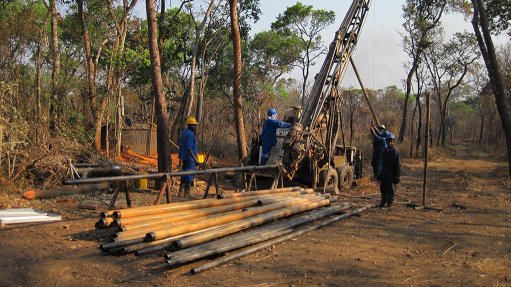
ON TRACK Drilling at the Mpokoto gold project will include deeper drilling and sulphide sampling, particularly at a drill hole referred to as hole 64, estimated to contain high ore grades
Aim-listed investment company Armadale Capital reaffirms that its 678 000 oz Mpokoto gold project, in the Katanga province of the Democratic Republic of the Congo (DRC), is on track for production in the first-half of 2016.
“Armadale is working towards completing the funding for the project and the definitive feasibility study (DFS) this year,” reiterates Armadale director Justin Lewis.
Mine construction is expected to start next month; however, this would be subject to receipt of financing, Armadale reported in September. The company has entered into agreements with contract mining services company Africa Mining Contracting Services, which would construct, operate and provide up to $20-million of finance for the Mpokoto project.
Armadale further continues to focus on the process route for gold recovery, with the company considering ways to simplify the route, Lewis tells Mining Weekly, noting that additional simplification will result in decreasing the overall production costs for an ounce of gold.
He further stresses that it is imperative to strike a balance in the overall capital expenditure (capex) of the project, the capex in producing the plant and the simplicity of the process chosen.
Lewis nevertheless believes that the project will deliver “a low capital and operational expenditure commercial gold mining project in the near future”.
The Mpokoto Gold Project
The project is located in the western part of the Katanga province, about 250 km west of Kolwezi, in the south-west of the DRC. Armadale notes that the area is highly prospective, as local operators include Canadian mineral exploration and development company Ivanhoe Mines and mining major Glencore.
The company expects a production rate of about 25 000 oz/y of gold over an initial nine-year mine life. Targeted production is estimated to have an average projected operating cost of $647/oz.
Mining Weekly in March reported that the metallurgical testwork carried out at the project had confirmed recoveries of 84% to 92%, which “significantly increase[d] the company’s confidence in the project’s proposed flowsheet”.
Armadale’s process route for gold recovery is a proposed two-phase approach based on recent metallurgical results. During the first phase, the majority of the ore feed is weathered and deeply oxidised. The phase will, therefore, entail scrubbing, milling, a batch Knelson concentrator to recover the free gold and flotation of the Knelson tailings. The flotation concentrate will be intensively cyanided.
During Phase 2, as the amount of weathered ore decreases and the proportion of transitional and fresh ore increases, the company will add a regrind ball mill to grind the flotation concentrate. A carbon-in-leach (CIL) circuit will also be added to leach the flotation tailings.
Lewis reiterates that recoveries of between 88% and 90% are expected on the weathered ore, and 84% on the transitional and fresh ore, before the CIL circuit is added.
In line with further expanding the resource at Mpokoto, Armadale is continuing a drilling programme at the project. The drilling will include deeper drilling and sulphide sampling, particularly at a drillhole referred to as hole 64, where Lewis believes significant promise lies. “Around hole 64 there are some very high gold grade intercepts of 10 g/oz to 20 g/oz and we are keen to explore this potential,” he adds.
While the programme will entail different phases in the short term, Armadale’s focus is on geotechnical drilling and hydrogeological drilling, the results of which will be used in the DFS and pit design, Lewis says, adding that additional resource drilling and soil sampling will be undertaken.
Shining Emergence
Lewis believes that gold has been one of the more resilient commodities – pricing at more than $1 000/oz last month – in the economic downturn.
“Traditionally, gold as a commodity is a safe haven and it, therefore, does well in times of volatility.”
However, he suggests that, considering the current macroeconomic environment, more volatility is to be expected in the near future, but stresses the need for low-cost production projects that will remain fairly profitable.
“These are the projects that will shine,” he avers, emphasising the return attraction and robust economics of the Mpokoto project, as it would be able to produce gold at an all-in cost of about $725/oz.
“Our focus has been on ensuring a substantially low operating cost of about $650/oz on C1 costs and about $725/oz on a C3 all-in costs,” he points out, adding that this provides a significant margin at fairly low gold prices.
Although he notes that these projects become more appealing, if the gold price continues to increase, he acknowledges the difficulty in attracting capital during the economic downturn, with mining companies, such as Armadale, having to deal with depressed valuations.